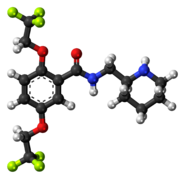 | |
 | |
| Clinical data | |
|---|---|
| Pronunciation | /flɛˈkeɪnaɪd/ fleh-KAY-nyde |
| Trade names | Tambocor, others |
| AHFS/Drugs.com | Monograph |
| MedlinePlus | a608040 |
| Drug class | Ic antiarrhythmic[1] |
| ATC code | |
| Legal status | |
| Legal status | |
| Pharmacokinetic data | |
| Bioavailability | 95% |
| Protein binding | 40% |
| Metabolism | CYP2D6 (limited) |
| Elimination half-life | 20 hours (range 12–27 hours) |
| Excretion | Kidney |
| Identifiers | |
| |
| CAS Number | |
| PubChem CID | |
| IUPHAR/BPS | |
| DrugBank | |
| ChemSpider | |
| UNII | |
| KEGG | |
| ChEBI | |
| ChEMBL | |
| CompTox Dashboard (EPA) | |
| ECHA InfoCard | 100.211.334 |
| Chemical and physical data | |
| Formula | C17H20F6N2O3 |
| Molar mass | 414.348 g·mol−1 |
| 3D model (JSmol) | |
| Chirality | Racemic mixture |
| |
| |
| | |
Flecainide is a medication used to prevent and treat abnormally fast heart rates.[1] This includes ventricular and supraventricular tachycardias.[1] Its use is only recommended in those with dangerous arrhythmias or when significant symptoms cannot be managed with other treatments.[1] Its use does not decrease a person's risk of death.[1] It is taken by mouth or injection into a vein.[1][3]
Common side effects include dizziness, problems seeing, shortness of breath, chest pain, and tiredness.[1] Serious side effects may include cardiac arrest, arrhythmias, and heart failure.[1] It may be used in pregnancy, but has not been well studied in this population.[3][4] Use is not recommended in those with structural heart disease or ischemic heart disease.[1] Flecainide is a class Ic antiarrhythmic agent.[1] It works by decreasing the entry of sodium in heart cells, causing prolongation of the cardiac action potential.[1]
Flecainide was approved for medical use in the United States in 1985.[1] It is available as a generic medication.[3] In 2021, it was the 205th most commonly prescribed medication in the United States, with more than 2 million prescriptions.[5][6]
- ^ a b c d e f g h i j k l "Flecainide Acetate Monograph for Professionals". Drugs.com. American Society of Health-System Pharmacists. Retrieved 7 April 2019.
- ^ "FDA-sourced list of all drugs with black box warnings (Use Download Full Results and View Query links.)". nctr-crs.fda.gov. FDA. Retrieved 22 Oct 2023.
- ^ a b c British national formulary : BNF 76 (76 ed.). Pharmaceutical Press. 2018. p. 103. ISBN 9780857113382.
- ^ "Flecainide (Tambocor) Use During Pregnancy". Drugs.com. Retrieved 7 April 2019.
- ^ "The Top 300 of 2021". ClinCalc. Archived from the original on 15 January 2024. Retrieved 14 January 2024.
- ^ "Flecainide - Drug Usage Statistics". ClinCalc. Retrieved 14 January 2024.